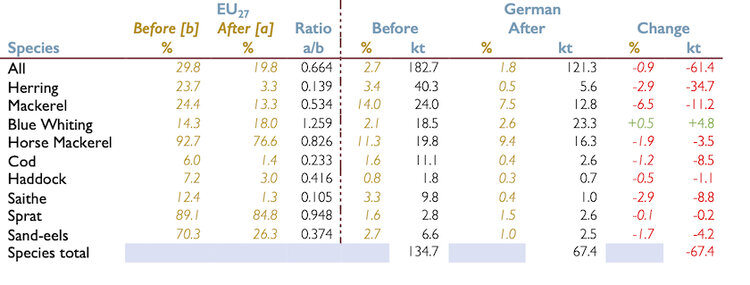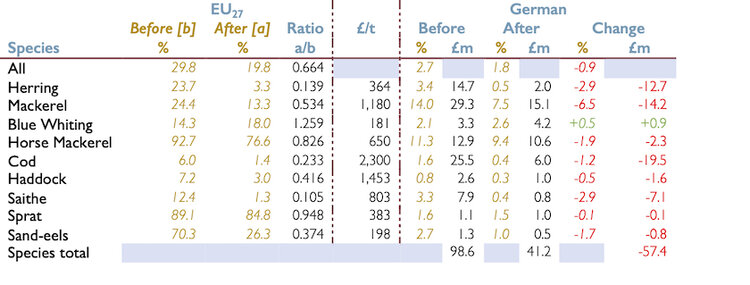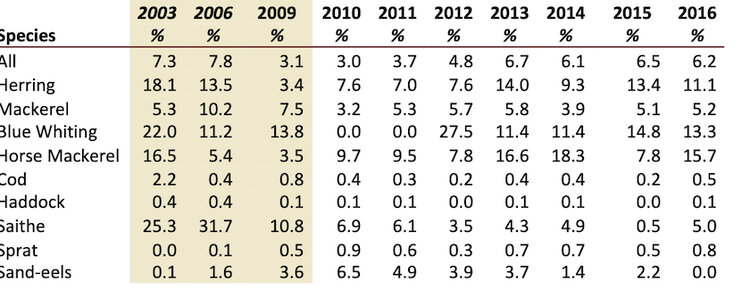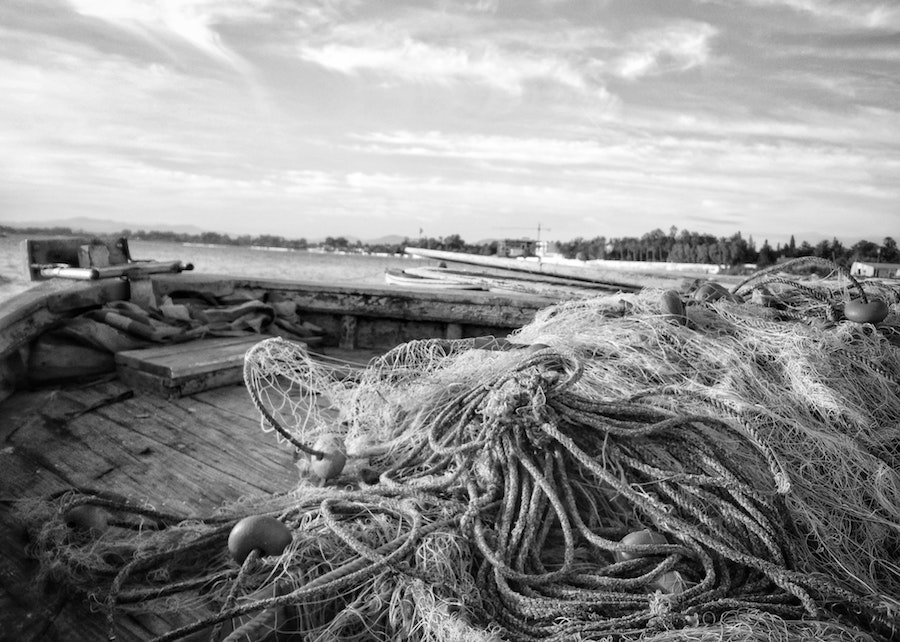Originally published August 2020.
This is the fifth in a group of articles looking at the possible impact of a post-Brexit redistribution of fishing opportunities in the NE Atlantic – and looks at Germany. It considers the same questions and uses the same methodologies as the first article, which looked at the Netherlands, and a fuller explanation of these is provided hereby that article.
The nine species making up the German basket for the tables in this article accounted for 73.7% of Germany’s average annual NE Atlantic landings for the years in question (see Table 1). Like the Netherlands, Denmark and Ireland, but unlike France, landings were dominated by low value, high tonnage pelagics – just four species or genera (Herring, Mackerel, Horse Mackerels and Blue Whiting) accounted for 56% of Germany’s total NE Atlantic landings. They are also responsible for the bulk of the lost tonnage: 66.2% of the basket losses and 72.6% of the losses projected for All species (with all the previously mentioned provisos).
On reaching Table 3, the alert reader will immediately notice that there is a problem with the German data: the sum of landings from the UK EEZ for the nine species being analysed individually exceeded landings for All species in 2009. This problem will be discussed in more detail later on but because of it, at this point, Germany’s overall potential loss of landings will be estimated using the ratio of the total for the basket of nine analysed species to the total for All species. On that basis, Germany is facing the loss of 91.5 kt, or roughly half of its fleet’s landings from the NE Atlantic.
In proportion to overall landings, this is the most severe haircut of all the fleets analysed so far and the loss is well in excess of total German landings from the UK EEZ. Given how close a shave it faces, surely Germany will be right behind Monsieur Barnier?
Table 1: German haircut, tonnage

As with French and Irish landings, this model strips Germany of tonnage as a consequence of the way the EU’s fishing rights in the Norwegian EEZ are secured through reciprocal Norwegian rights that are largely exercised in the UK EEZ. For example, based on average landings for 2010 to 2016, the model is projecting a loss of 8.5 kt of Cod for Germany, yet Germany only lands 59.6 tonnes of Cod from the UK EEZ; and a loss of 8.8 kt of Saithe, yet Germany only landed 1.4 kt of Saithe from the UK EEZ.
These two species are just examples, Germany is also modelled to lose more Mackerel, Haddock, Sprat and Sand-eels tonnage than it landed from the UK EEZ.
So much for tonnage. What about money in the bank? Table 2 repeats Table 1 but replaces kt landed with £m in first sale values[1].
Table 2: German haircut, value

Unlike tonnage, the greatest loss is accounted for by Cod rather than the pelagics, though, as a group Herring, Mackerel, Horse Mackerel and Blue Whiting (49.3% of the basket’s loss) are roughly on a par with the Cod group and account for the overwhelming bulk of the basket’s loss (98.4%).
Adjusting in the same way as for tonnage, the German fleet is facing losses in the region of £77.9 m. This is roughly similar to potential Irish losses but the German economy is some eleven times the size of the Irish one. Who will take the bigger hit? On a PPP basis, German GDP was estimated at $4.343 trillion in 2019. At current exchange rates (£1 : $1.31) that is £3.315 trillion. A loss of £77.9 million in first sale values represents 0.002% of German GDP.
It is often said that the UK fishing industry is a relatively small part of the UK economy and it is sometimes argued that the UK will or should trade its interests for concessions in other areas; but nowhere in northern Europe is it as small, in relative terms, as it is in Germany. Is the land of Mercs and Beamers really going out on a limb for 0.002% of its GDP and to save Ireland’s and Denmark’s bacon?
Tables 1 and 2 are based on average annual landings for the period 2010 to 2016 and model how German landings might change as a result of an overall redistribution of fishing opportunities in the NE Atlantic. However, the use of average values, whilst it smooths out swings and roundabouts, may also conceal trends; and, specifically – since this series of articles is concerned with the mismatch between the fishing opportunities allocated to the UK fleet by the EU under the CFP compared with landings from the UK EEZ – whether EU27 fleets are increasing or decreasing the amounts of fish they land from the UK EEZ.
The EH99 database holds figures for annual landings in 2003, 2006 and 2009 – 2016 and Table 3 presents annual German landings from the UK EEZ for All species and for the nine individual ones featured in Tables 1 and 2 so that the reader can assess for him- or herself how the situation has been changing over time.
All the above being said, what the use of averages really conceals in the case of Germany is problems. Read on.
Table 3, however, is a table of absolute tonnages and it is possible that changes in German landings simply reflect changes in the overall position. Tables 4 and 5 present the percentage shares of German NE Atlantic landings taken from the UK EEZ and the percentage of landings from the UK EEZ taken by the German fleet for the same panel of species.
Table 3: German landings from the UK EEZ, tonnage

Table 3 shows German landings from the UK EEZ between 2003 and 2016. The alert reader will notice that there is a problem in 2009. Namely that the sum of the parts is more than the whole. It is possible that this clear glitch in the database is an indicator of a more general problem. There was also a sharp drop in overall landings, paralleled by falls for landings of Herring and Blue Whiting, in 2009, with landings not recovering in full until 2013, plus falls for Mackerel in 2010 and for Horse Mackerel in 2006 and 2009. Rather than reflecting actual falls in landings, might these apparent falls be further symptoms of a more general problem in the underlying database for 2009 and 2010 in particular but also, to a lesser extent, 2011 and 2012?
If there are errors in the German figures for these years, how serious would this be for the analysis of German landings? Whilst it isn’t good news, it’s not as bad as it might first appear. Firstly, 2009, the year that appears to be worst affected, is not included in the sequence of years (2010-2016) used to generate most of the averages. Secondly, the zonal attachment/resource share element of the redistribution is based on the share landed by the EU27 and from the EU27 EEZ. Whilst German landings contribute to these totals, their contribution is a relatively minor one and it is only once the next stage of the redistribution is reached that missing German figures would really have an impact.
If German figures are missing for some species or years, then the German share of EU27 landings would be correspondingly lower both before and after the redistribution; but the factor by which German landings are reduced would be unaltered, since that factor is determined by the ratio between landings by the EU27 fleet and landings from the EU27 EEZ.
Table 4: Percentage of German NE Atlantic landings from the UK EEZ
i.e. how important has the UK EEZ been to Germany?

As with the tonnages landed presented in Table 3, Table 4 exhibits a bathtub curve for All species and the pelagics: the dip in landings is paralleled by a dip in the percentage taken from the UK EEZ. Comparing Tables 3 and 4 with overall German landings from the NE Atlantic (the EH99 database has these figures but they are not reproduced here) reveals that, very roughly German landings from parts of the NE Atlantic outwith the UK EEZ remained steady during the years when those from the UK EEZ fell. The German fleet appears to have reduced landings from the UK EEZ without correspondingly increasing them from elsewhere. Was that because there were fewer fish to catch in the UK EEZ or, as suggested previously, is some data for German landings missing?
Landings by a number of other fleets do show progressively rising tonnages and percentages taken from the UK EEZ in the later years of the sequence and some, especially the Dutch, do exhibit a bath tub effect but none exhibit such a deep one as the German fleet. If German landings and percentages from the UK EEZ really reflected resource availability might one not expect other fleets to exhibit similar patterns?
Table 5: Percentage of EU28 landings from the UK EEZ taken by the German fleet
i.e. how big a player has Germany been in the UK EEZ?

Here too, for All species and the pelagics, the German fleet goes AWOL during the middle years (although remember French and Spanish figures are missing for 2003, 2006 and 2009) but is this because it was concentrating its efforts elsewhere and so less of a presence in the UK EEZ or because some of the data is missing?
The fact the proportion of landings from the UK EEZ taken by the German fleet in the middle years dipped indicates that reduced German landings from the UK EEZ was not because there were fewer fish there to catch but because other fleets were landing them. If the figures are correct, why? The previous tables in this article and the EH99 database indicate that the German fleet did not switch its efforts to other areas. Table 5 indicates there were fish to catch in the UK EEZ it was just that it was someone other than the German fleet that caught them. If the figures are correct, why? Or is it that the figures are not correct?
In Tables 3, 4 and 5 it is for All species and the pelagics that the bath tub form is most pronounced but these are the species that account for far and away the bulk of the tonnage landed by the German fleet from the UK EEZ. Although accounting for almost half the lost tonnage because of the way the model redistributes landings, the Cod group, where the bath tub is less pronounced or nor present at all, only accounted for a small proportion of landings.
In short, do the bath tub curves exhibited by the pelagics, which dominate landings in tonnage terms, really reflect actual landings or are the various odd features discussed above indications that there are problems in the underlying database? Since the EU has now removed the source database in question from its website, it is difficult to investigate further.
Subscribe to our tea-time newsletter here, and follow us on Twitter here and facebook here.
After a first degree in zoology followed by research in developmental genetics, Neil Stratton worked for a number of European publishers before beginning an analysis of European fish landings with the think tank EH99 in the spring of 2018. The recently published report Fair Shares for All is based on this analysis.
Article originally published by Brexit Watch.








